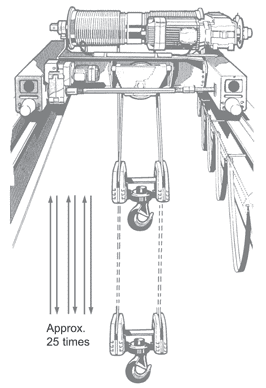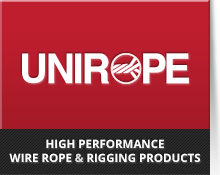| Run-In Period After installing a new rope it is necessary to run it through its operating cycle several times under light load and at reduced speed. This allows the rope to adjust itself to the working conditions and enable all strands and wires to become seated. Depending on rope type and construction some rope stretch and a slight reduction in rope diameter will occur as the strands and core are compacted. The rope is less liable to be damaged when full load is applied. The initial stretch (constructional stretch) is a permanent elongation that takes place due to slight lengthening of the rope lay and due to a slight decrease in rope diameter. Constructional stretch generally takes place during the first 10-20 lifts, and increases the rope length by between 1/2% for fiber core rope, approx. 1/4% for 6-strand steel core rope, and approaches zero for compacted Python® ropes. If you have the chance and the equipment configuration allows this, disconnect the rope end after the run-in-period to allow any possible torque and twists which may have developed during installation and the run-in-period to be released at the end connection. |
Equipment Testing In many cases the crane equipment has to be tested prior to use. Proof testing requires to purposely overload the crane to varying degrees. The magnitude of overloading depends on the type and capacity of the crane and which governing authority certifies the equipment. The test may impose an overload of between 10% and 100% of the crane’s rated capacity. Under NO circumstances must the crane be tested prior to the break in procedure of the wire rope. If you overload a rope which has not yet been broken in, you may inflict permanent damage to the rope. Equipment with multiple layer windings call for additional caution. As mentioned before, severe overloads of the top layers may damage the lower ones or may crush the rope. If possible, test the crane with the rope spooled in the first drum layer only. If the crane is equipped with a smooth drum, special care must be taken to ensure that the rope does not cross-wind over itself when testing the crane. After testing (overloading) you have to repeat the spooling procedure as outlined here ‘Winding on smooth or flat faced drums’. |
 |
| Start with light loads and increase gradually to full capacity. |



